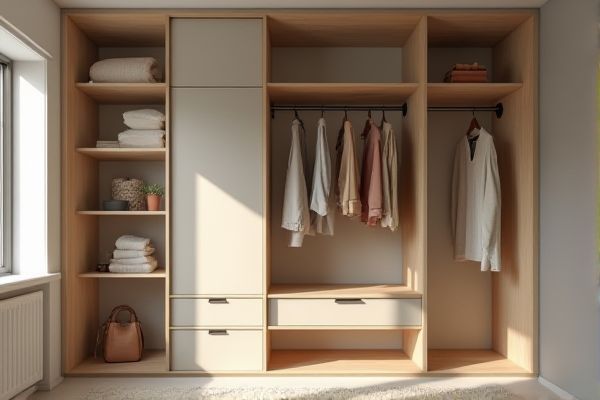
A closet body form provides a three-dimensional shape to better visualize how your clothes will fit and drape, unlike hangers which only support garments flatly and can cause misshaping over time. Explore the rest of the article to discover how choosing the right option can enhance your wardrobe organization and garment care.
Table of Comparison
| Feature | Closet Body Form | Hanger |
|---|---|---|
| Purpose | Shape retention and display of clothing | Support and organize hanging clothes |
| Material | Plastic, fiberglass, foam | Plastic, wood, metal |
| Space Efficient | Less space efficient, bulky | Highly space efficient |
| Clothing Type | Best for jackets, shirts, dresses | Suitable for shirts, pants, coats |
| Durability | Moderate, prone to wear | High, depends on material |
| Cost | Higher price range | Generally low cost |
| Usage | Ideal for tailoring and display | Everyday use in closets |
Closet Body Form vs Hanger: Key Differences
Closet body forms provide a three-dimensional representation of the human torso, allowing garments to maintain their shape and fit realistically, unlike hangers which often cause stretching or misshaping. Body forms are ideal for precise garment fitting, tailoring, and display, enhancing the accuracy of adjustments compared to the flat suspension provided by hangers. While hangers are practical for general storage and space efficiency, closet body forms offer superior support for preserving the structural integrity of clothing.
Benefits of Using a Closet Body Form
Using a closet body form enhances garment care by maintaining the shape of clothing, preventing wrinkles and fabric distortion that often occur with hangers. This method supports delicate fabrics like silk and wool, prolonging the life of high-quality garments while offering a more organized and visually appealing closet space. Closet body forms also facilitate easier outfit planning and fitting adjustments, making them an essential tool for fashion enthusiasts and professionals.
Advantages of Traditional Hangers
Traditional hangers offer superior breathability and air circulation, preventing moisture buildup that can lead to mold or fabric damage. Their lightweight design makes them easy to handle and ideal for organizing a wide variety of clothing types, from shirts to jackets. Hangers also provide quick access and space-saving benefits, maximizing closet efficiency without the bulk of a body form.
Preserving Garment Shape: Which Is Better?
Closet body forms preserve garment shape more effectively than hangers by maintaining the natural contours of clothing, preventing stretching and deformation commonly caused by wire or plastic hangers. Body forms distribute the weight of garments evenly across the shoulders and torso, reducing stress points that can lead to misshaping. Hangers often cause shoulder bumps and sagging, while closet body forms provide structural support that helps retain the original fit and silhouette of delicate fabrics and tailored pieces.
Space Efficiency: Body Form vs Hanger
Closet body forms provide a compact and structured way to store clothing, maximizing vertical space by maintaining garment shape without the bulk often created by multiple hangers. Hangers, while versatile, can lead to overcrowding and inefficient use of horizontal closet space, especially when storing delicate or bulky items. Your choice between body form and hanger directly impacts closet organization and space efficiency, with body forms offering a sleek, space-saving solution ideal for optimizing limited closet areas.
Best Uses for Closet Body Forms
Closet body forms are best used for tailoring, visual garment fitting, and organizing outfits, offering a three-dimensional representation of your body shape that hangers cannot provide. They help maintain the structure of delicate or fitted clothing such as dresses, suits, and tailored jackets, preventing stretching and distortion. Your closet benefits from body forms when you want accurate fitting previews and streamlined outfit planning.
When to Choose Hangers Over Closet Body Forms
Choose hangers over closet body forms when you need to maximize closet space and maintain garment shape without bulk. Hangers are ideal for lightweight clothing like shirts, blouses, and jackets that benefit from natural draping to prevent wrinkles. Your wardrobe will stay organized and accessible when you use hangers for everyday wear and closet body forms for specialized garment display or tailoring.
Impact on Clothing Longevity
Closet body forms provide superior support by mimicking natural human contours, which helps maintain the shape and fabric integrity of garments over time. Unlike standard hangers, body forms prevent stretching and shoulder bumps, reducing wear and tear on delicate fabrics. Properly supporting clothes on body forms significantly extends their longevity compared to traditional hanger storage.
Cost Comparison: Closet Body Form vs Hanger
Closet body forms typically range from $50 to $200 depending on material and detail, while standard hangers cost between $1 and $10 each, making hangers more budget-friendly for large quantities. Although closet body forms have a higher upfront cost, they provide superior garment shaping for tailoring and display, potentially reducing fabric waste and alterations. Investing in closet body forms may be cost-effective over time for fashion professionals seeking precise fit, whereas hangers remain economical for basic garment storage.
Choosing the Right Option for Your Wardrobe
Closet body forms provide structured support, maintaining the shape of garments such as suits, dresses, and tailored clothing, preventing wrinkles and fabric distortion. Hangers offer a versatile, space-saving storage solution suitable for lighter fabrics and casual wear but may cause stretching or misshaping if improperly used. Selecting between a closet body form and hanger depends on wardrobe composition, garment delicacy, and desired maintenance of clothing silhouette.
 homyna.com
homyna.com